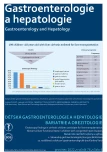“Vanishing bile duct syndrome” as a manifestation of drug-induced liver damage in a patient after polytrauma
Authors:
X. Faktorová 1
; M. Žigrai 1
; Žigraiová S. 1; Horniaková L. 2; S. Adamcová Selčanová 3
; Belica R. 1; Guga D. 1; Vyskočil M. 1
Authors place of work:
Interná klinika SZU, Univerzitná nemocnica – Nemocnica svätého Michala, a. s., Bratislava
1; III. interná klinika LF UK a UN Bratislava
2; Hepatologicko-gastroenterologické a transplantačné oddelenie (HEGITO), II. interná klinika SZU, Banská Bystrica
3
Published in the journal:
Gastroent Hepatol 2022; 76(6): 499-503
Category:
Hepatologie: kazuistika
doi:
https://doi.org/10.48095/ccgh2022499
Summary
Vanishing bile duct syndrome is a type of drug-induced cholestatic liver injury that occurs when the body is exposed to drugs or other foreign substances. We hospitalized a 44-year-old, so far healthy, male with gradually developing painless icterus and pruritus of the whole body after severe polytrauma. The patient had previously undergone a complex treatment (antibiotics, antifungals, parenteral nutrition, LMWH). Laboratory tests revealed a several-fold elevation of total and conjugated bilirubin with a 3-fold increase in ALP levels, no significant elevation of transaminases, a decrease in prothrombin time and IgG4 antibody positivity. An MRCP scan was performed revealing irregular intrahepatic bile ducts, a dilated common bile duct and characteristics of primary or secondary sclerosing cholangitis. Further examinations ruled out infectious, metabolic, toxic and oncological causes of hepatopathy. A liver biopsy ruled out both autoimmune hepatitis and IgG4 hepatopathy and displayed images of “vanishing bile duct syndrome” in drug-induced liver injury (DILI). Empirical treatment with high-dose intravenous N-acetylcysteine and other hepatoprotective agents led to a gradual decrease of bilirubin, normalization of coagulation parameters and remission of icterus and clinical complaints. This case report points to a cholestatic type of drug-induced liver injury with histologically confirmed vanishing bile duct syndrome and the need to think of DILI as one of the causes of the otherwise unexplained hepatopathy.
Keywords:
cholangitis – IgG4 – hepatopathy – DILI – vanishing bile duct syndrome
Zdroje
1. Andrade RJ, Chalasani N, Björnsson ES et al. Drug-induced liver injury. Nat Rev Dis Primers 2019; 5 (1): 58. doi: https: //doi.org/10.1038/ s41572-019-0105-0.
2. Larson AM. Drug-induced liver injury. [online]. Dostupné z: https: //www.uptodate.com/contents/drug-induced-liver-injury.
3. David S, Hamilton JP. Drug-induced liver injury. US Gastroenterol Hepatol Rev 2010; 6 : 73–80.
4. European Association for the Study of the Liver. EASL Clinical Practice Guidelines: drug-induced liver injury. J Hepatol 2019; 70 (6): 1222–1261. doi: 10.1016/j.jhep.2019.02.014.
5. Hassan A, Fontana RJ. The diagnosis and management of idiosyncratic drug-induced liver injury. Liver Int 2019; 39 (1): 31–41. doi: 10.1111/liv.13931.
6. Fisher K, Vuppalanchi R, Saxena R. Drug-induced liver injury. Arch Pathol Lab Med 2015; 139 (7): 876–887. doi: 10.5858/arpa.2014-0214-RA.
7. Szántová M. Hepatológia stručne, jasne, prehľadne. Bratislava: A-medi management 2019.
8. Park JH, Hong S, Jun DW et al. Prevalence and clinical characteristics of antibiotics associated drug induced liver injury. Ann Transl Med 2021; 9 (8): 642. doi: 10.21037/atm-20-5144.
9. Katarey D, Verma S. Drug-induced liver injury. Clin Med (Lond) 2016; 16 (6): 104–109. doi: 10.7861/clinmedicine.16-6-s104.
10. Kleiner DE. Drug-induced liver injury: the hepatic pathologist‘s approach. Gastroenterol Clin North Am 2017; 46 (2): 273–296. doi: 10.1016/ j.gtc.2017.01.004.
11. Sundaram V, Björnsson ES. Drug-induced cholestasis. Hepatol Commun 2017; 1 (8): 726–735. doi: 10.1002/hep4.1088.
12. Desmet VJ. Vanishing bile duct syndrome in drug-induced liver disease. J Hepatol 1997; 26 (1): 31–35. doi: 10.1016/s0168-8278 (97) 823 30-6.
13. Chalasani NP, Maddur H, Russo MW et al. ACG Clinical Guideline: diagnosis and management of idiosyncratic drug-induced liver injury. Am J Gastroenterol 2021; 116 (5): 878–898. doi: 10.14309/ajg. 0000000000001259.
14. Chughlay MF, Kramer N, Spearman CW et al. N-acetylcysteine for non-paracetamol drug-induced liver injury: a systematic review. Br J Clin Pharmacol 2016; 81 (6): 1021–1029. doi: 10.1111/bcp.12880.
15. Siu JT, Nguyen T, Turgeon RD. N-acetylcysteine for non-paracetamol (acetaminophen) -related acute liver failure. Cochrane Database Syst Rev 2020; 12 (12): CD012123. doi: 10.1002/14651858.
Štítky
Dětská gastroenterologie Gastroenterologie a hepatologie Chirurgie všeobecnáČlánek vyšel v časopise
Gastroenterologie a hepatologie

2022 Číslo 6
- Horní limit denní dávky vitaminu D: Jaké množství je ještě bezpečné?
- Metamizol jako analgetikum první volby: kdy, pro koho, jak a proč?
- Diagnostika virových hepatitid v kostce – zorientujte se (nejen) v sérologii
- Neodolpasse je bezpečný přípravek v krátkodobé léčbě bolesti
Nejčtenější v tomto čísle
- Dificlir – fidaxomicin – efektivní varianta léčby infekcí C. difficile u dětí
- „Vanishing bile duct syndróm“ ako prejav poliekového poškodenia pečene u pacienta po polytraume
- 17. vzdělávací a diskuzní gastroenterologické dny
- Titanlax – profil zdravotnického prostředku
